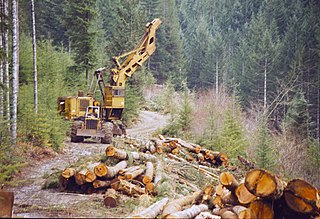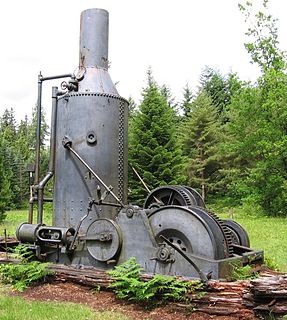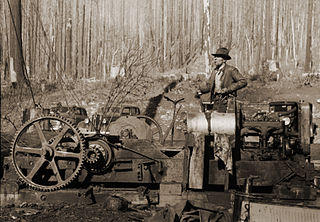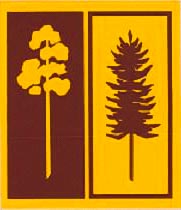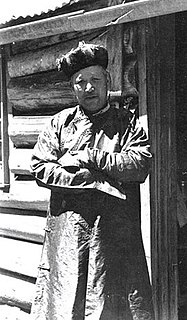
The Washington Iron Works Skidder is a steam-powered logging skidder, or cable winch. It was imported to Australia in the 1920s and was initially used to move the large Jarrah logs from the forests of Western Australia.

A steam engine is a heat engine that performs mechanical work using steam as its working fluid. The steam engine uses the force produced by steam pressure to push a piston back and forth inside a cylinder. This pushing force is transformed, by a connecting rod and flywheel, into rotational force for work. The term "steam engine" is generally applied only to reciprocating engines as just described, not to the steam turbine.

Logging is the cutting, skidding, on-site processing, and loading of trees or logs onto trucks or skeleton cars.

A skidder is any type of heavy vehicle used in a logging operation for pulling cut trees out of a forest in a process called "skidding", in which the logs are transported from the cutting site to a landing. There they are loaded onto trucks, and sent to the mill. One exception is that in the early days of logging, when distances from the timberline to the mill were shorter, the landing stage was omitted altogether, and the "skidder" would have been used as the main road vehicle, in place of the trucks, railroad, or flume. Modern forms of skidders can pull trees with a cable/winch, just like the old steam donkeys, or a grapple or a clam-bunk.
Contents
The winch was sold to the Forests Commission Victoria for salvaging timber in the Central Highland on the Toorongo Plateau near Noojee after the 1939 Black Friday fires.
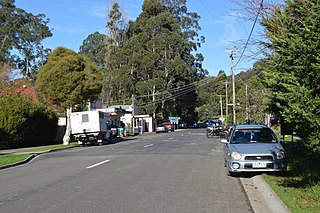
Noojee is a town in the Gippsland region of Victoria, Australia, north of Warragul and east of Melbourne, in the Baw Baw local government area. At the 2006 census, Noojee and the surrounding area had a population of 261. The town benefits from tourists passing through to the Mount Baw Baw Alpine Resort, 48 kilometres away, as it is the last stop with tourism services. There are also a number of walks in the area, including the Noojee Trestle Bridge, a 100m wooden rail bridge.
It was later sold and moved to its present site by local sawmilling company Ezards in 1959 where it operated until 1961-62. A logging camp supported men operating the machine.
The winch is located east of Swifts Creek, Victoria, near Bentley Plain and is a unique part of Victoria's cultural heritage and logging history; left intact with engine, spars and cabling still rigged for work it is the only steam-powered engine of its kind in Australia. It is listed on the Victorian Heritage Register, [1] and managed by the Department of Environment, Land, Water and Planning (DELWP).

The Victorian Heritage Register (VHR) lists places deemed to be of cultural heritage significance to the State of Victoria, Australia. It has statutory weight under the Heritage Act 1995 which established Heritage Victoria as the State Government listing and permit authority. Listing on the Victorian Heritage Register is separate from listing by a local Council or Shire, known as a Heritage Overlay. Heritage Victoria is currently part of the Department of Environment, Land, Water and Planning of the Government of Victoria, Australia. Heritage Victoria reports to the Heritage Council who approve recommendations to the Register and hear appeals when a registration is disputed. The Council also hears appeals by an owner to a permit issued by Heritage Victoria. The Minister for Planning is the responsible Minister for Heritage Victoria and the Heritage Act 1995. As of 2013, there were over 2,200 places and objects listed on the VHR.

The Department of Environment, Land, Water and Planning (DELWP) is a government department in Victoria, Australia.






